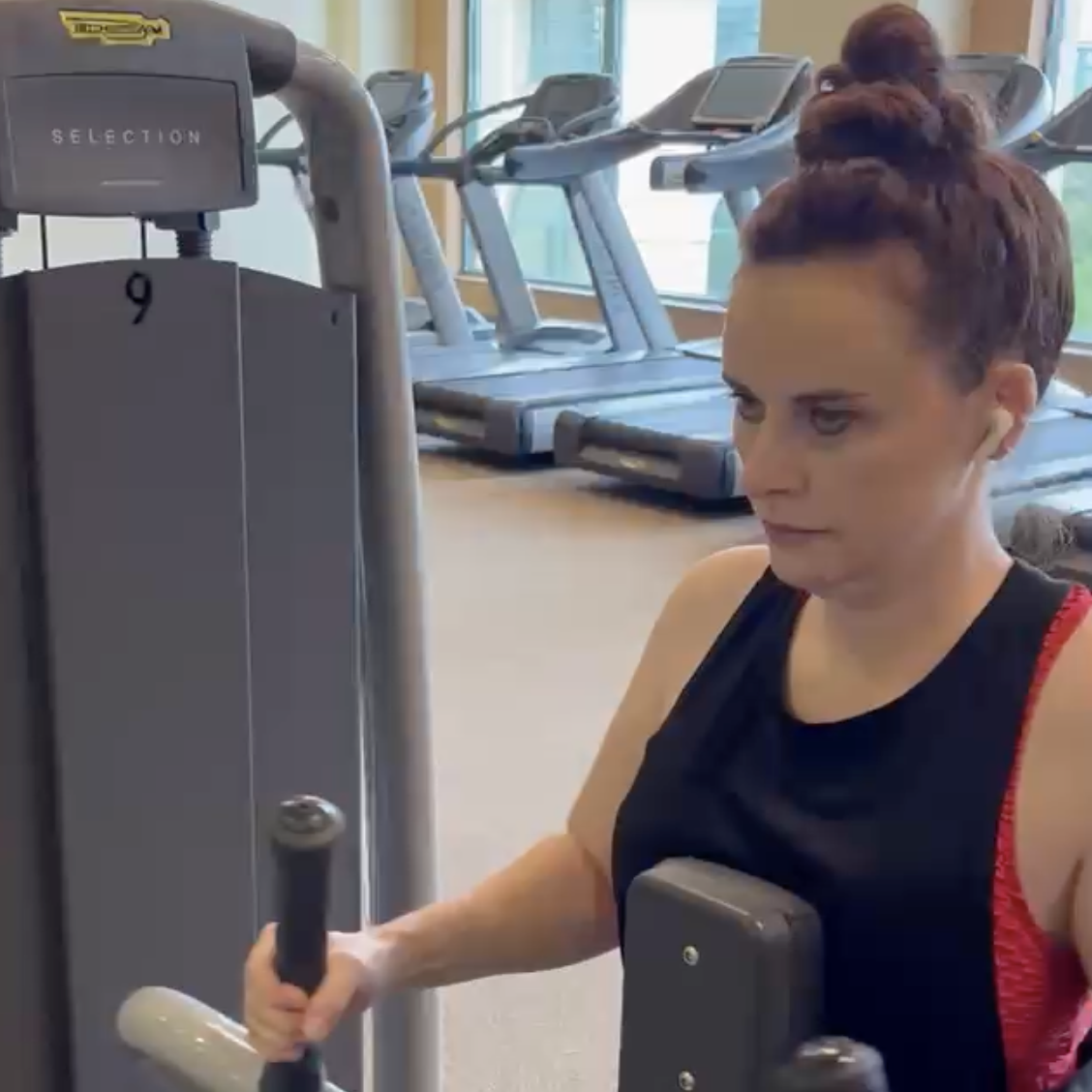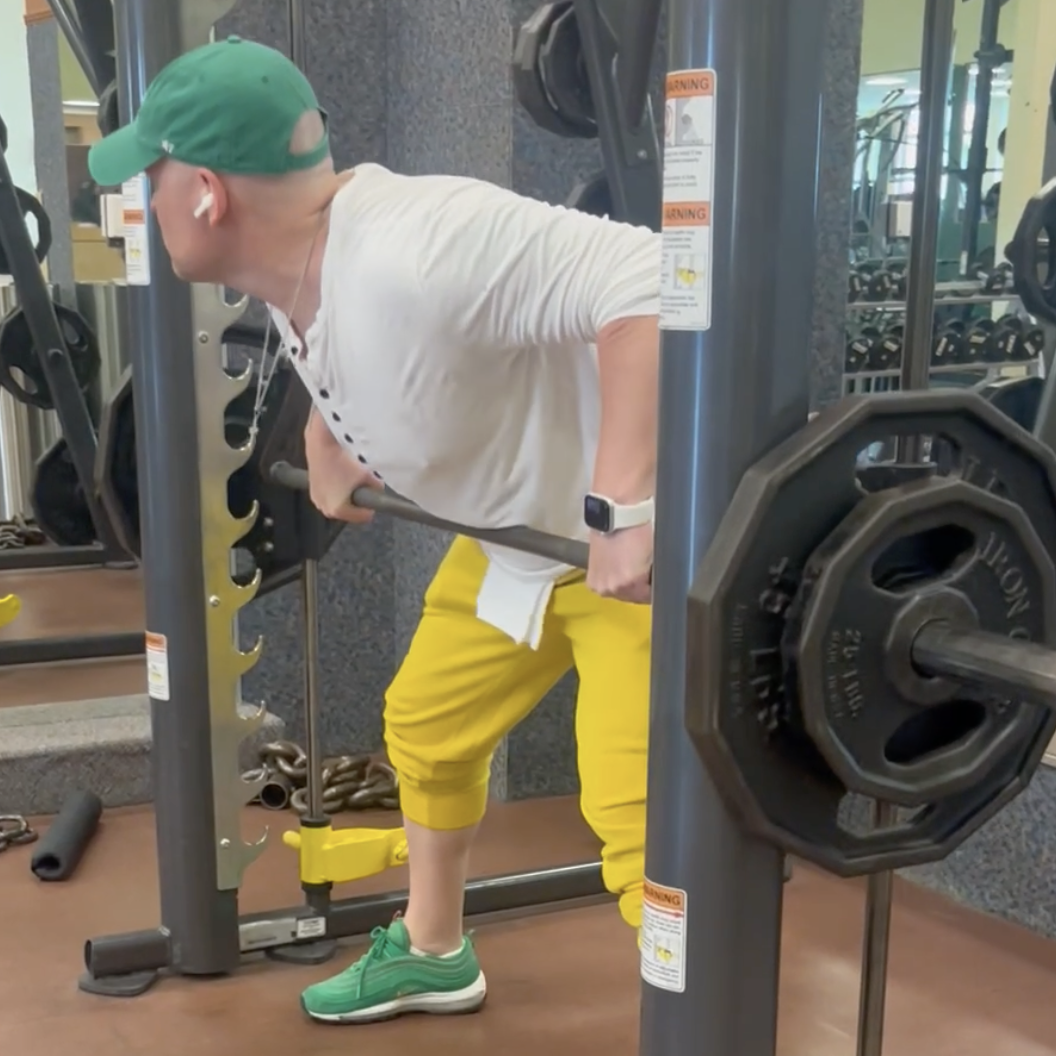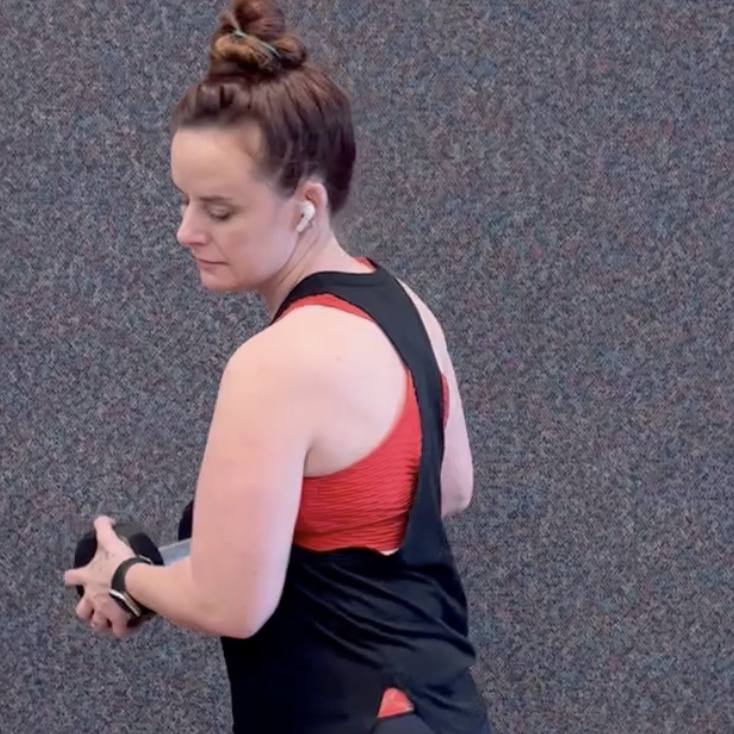Back Workout 1
#BackWorkout
Instructions:
Warm Up
✅ Start with a weight that is easy and does not cause strain or heavy breathing.
Reverse Pyramid
✅ On your first heavy weight: Do a weight that you can do 4-6 reps. Then decrease the weight by 10% for each of the following reps. Once you hit the max you can do, increase your weight. Rinse and repeat as you get stronger.
Rest Pause
✅ Rest Pause is 4 Rounds. The first set is larger and the other three are smaller. The weight stays the same for all rounds. If you can do 12 Reps and 6 Reps with only 15 seconds of rest easily, then increase the Rep count to 14 and 7.
Abs
✅ You have Two Options: Option 1: You can do 1 Set of 60 OR Option 2: 3 Sets of 20 (you can mix it in between the exercises as you do the workout)
The Workout
1. Barbell Bent Over Row (Reverse Pyramid)
Example: (adjust weight according to what works best for you)
Warm up: 4-6 Reps: 30 pounds (then do 1 minute rest)
Warm up: 4-6 Reps: 40 pounds (then do 2 minute rest)
Round 1 – Do 4-6 Reps: 60 pounds (then do 3 minute rest)
Round 2 – Do 6-8 Reps: 50 pounds (then do 3 minute rest)
Round 3 – Do 8-10 Reps: 40 pounds (then do 3 minute rest)
2. Barbell Bent Over Row (Rest Pause)
Example: (adjust weight according to what works best for you)
Round 1 – Start at 12 Reps for your first set (then do 15 second rest)
Round 2 – Do 6 Reps (then do 15 second rest)
Round 3 – Do 6 Reps (then do 15 second rest)
Round 4 – Do 6 Reps (then do 15 second rest)
3. Machine Row (Reverse Pyramid)
Example: (adjust weight according to what works best for you)
Warm up: 4-6 Reps: 30 pounds (then do 1 minute rest)
Warm up: 4-6 Reps: 40 pounds (then do 2 minute rest)
Round 1 – Do 4-6 Reps: 60 pounds (then do 3 minute rest)
Round 2 – Do 6-8 Reps: 50 pounds (then do 3 minute rest)
Round 3 – Do 8-10 Reps: 40 pounds (then do 3 minute rest)
4. Machine Row (Rest Pause)
Example: (adjust weight according to what works best for you)
Round 1 – Start at 12 Reps for your first set (then do 15 second rest)
Round 2 – Do 6 Reps (then do 15 second rest)
Round 3 – Do 6 Reps (then do 15 second rest)
Round 4 – Do 6 Reps (then do 15 second rest)
5. Seated Cable Row (Reverse Pyramid)
Example: (adjust weight according to what works best for you)
Warm up: 4-6 Reps: 30 pounds (then do 1 minute rest)
Warm up: 4-6 Reps: 40 pounds (then do 2 minute rest)
Round 1 – Do 4-6 Reps: 60 pounds (then do 3 minute rest)
Round 2 – Do 6-8 Reps: 50 pounds (then do 3 minute rest)
Round 3 – Do 8-10 Reps: 40 pounds (then do 3 minute rest)
6. Seated Cable Row (Rest Pause)
Example: (adjust weight according to what works best for you)
Round 1 – Start at 12 Reps for your first set (then do 15 second rest)
Round 2 – Do 6 Reps (then do 15 second rest)
Round 3 – Do 6 Reps (then do 15 second rest)
Round 4 – Do 6 Reps (then do 15 second rest)
7. Abs: Dumbbell Torso Twist
Two Options:
Option 1: Set of 60 (each side)
Option2: 3 Sets of 20 (each side) – You can mix it in between the exercises as you do the workout.
8. Abs: Kneeling Cable Crunch
Two Options:
Option 1: One Set for 60
Option 2: 3 Sets of 20 – You can mix it in between the exercises as you do the workout.



Back Workout 1
A well-rounded fitness routine should always include back workouts. The back muscles, although often overlooked, play a crucial role in maintaining posture, supporting the spine, and facilitating daily movements such as lifting and bending. Developing a strong back helps improve overall strength, stability, and aesthetics.
Barbell Bent Over Row
How to Perform the Barbell Bent Over Row
The Barbell Bent Over Row is a compound exercise that targets multiple muscles in your back, specifically the latissimus dorsi, rhomboids, traps, and lower back. It also engages the biceps, making it a great overall upper body strength-building movement. Here’s how to perform it:
- Setup: Stand with your feet shoulder-width apart and hold a barbell with a pronated (overhand) grip. Keep your knees slightly bent and hinge at the hips until your torso is at about a 45-degree angle to the floor. Keep your back straight and your chest up.
- Engagement: Engage your core and pull the barbell towards your lower chest, keeping your elbows close to your body. Squeeze your shoulder blades together at the top of the movement.
- Lowering: Slowly lower the barbell back to the starting position, maintaining control throughout the movement.
- Repetitions: Perform 8-12 reps for 3-4 sets.
Benefits of the Barbell Bent Over Row
- Strengthens the Upper and Lower Back: This exercise works several major muscles in the back, including the lats, rhomboids, and traps. Strengthening these muscles improves posture and reduces the risk of injury during other activities.
- Engages the Core: Maintaining the bent-over position requires core stabilization. This makes the exercise excellent for improving core strength, which enhances overall body stability and balance.
- Promotes Functional Strength: The Barbell Bent Over Row mimics pulling movements in real-life activities, making it a functional exercise that translates to everyday tasks such as lifting, pulling, or moving objects.
- Improves Posture: Strengthening the back muscles helps counteract the effects of slouching, particularly for people who sit for long periods, and promotes a more upright posture.
Machine Row
How to Perform the Machine Row
The Machine Row is a more controlled exercise than the Barbell Bent Over Row, making it ideal for beginners or those recovering from an injury. It allows you to isolate the back muscles without worrying too much about stabilizing your body. Here’s how to do it:
- Setup: Adjust the machine seat so that the handles are in line with your mid-torso. Sit down, place your feet on the footrest, and grasp the handles with a neutral or pronated grip.
- Engagement: Keep your back straight and pull the handles towards your torso, squeezing your shoulder blades together at the peak of the movement.
- Return: Slowly return the handles to the starting position, allowing your arms to fully extend but without letting your shoulders round forward.
- Repetitions: Perform 10-15 reps for 3-4 sets.
Benefits of the Machine Row
- Isolates the Back Muscles: Since you’re seated and the machine supports your body, you can focus more on engaging the back muscles without worrying about form or balance. This isolation helps you to target specific muscles like the rhomboids and lats more effectively.
- Lower Risk of Injury: The machine provides a controlled range of motion, reducing the chance of improper form or overextending the muscles. This makes it a safer option for those with lower back problems or beginners still learning correct lifting mechanics.
- Consistent Resistance: Using a machine ensures that the resistance remains consistent throughout the entire range of motion, allowing for a better contraction of the targeted muscles.
- Scalability: The machine allows you to easily adjust the weight, making it an excellent tool for progressive overload—one of the key principles for muscle growth.
Seated Cable Row
How to Perform the Seated Cable Row
The Seated Cable Row is another fundamental back exercise that targets the middle and lower back, as well as the biceps. It uses a cable machine, which provides constant tension throughout the movement, ensuring that the muscles are engaged from start to finish. Here’s how to do it:
- Setup: Sit at a cable row machine with your feet firmly placed on the footrests. Grab the handle (usually a V-bar or straight bar) with both hands, and sit upright with your knees slightly bent.
- Engagement: Keeping your back straight, pull the handle towards your torso, aiming for your belly button. As you pull, keep your elbows close to your sides and focus on squeezing your shoulder blades together.
- Return: Slowly extend your arms to return to the starting position, ensuring that your back stays straight throughout the movement.
- Repetitions: Perform 10-12 reps for 3-4 sets.
Benefits of the Seated Cable Row
- Improves Postural Strength: Like other back exercises, the Seated Cable Row strengthens the muscles responsible for good posture, particularly the rhomboids and lower traps. This helps prevent the rounded shoulders and slouched posture common in those who sit for long periods.
- Builds Muscle Mass: The Seated Cable Row effectively targets the mid-back, contributing to muscle hypertrophy and a more sculpted appearance. It’s an excellent exercise for adding thickness to your back, especially when combined with other compound movements.
- Enhances Core Stability: To maintain proper form during the Seated Cable Row, you need to engage your core, which helps improve overall stability and balance.
- Works the Arms: This exercise also provides a solid workout for the biceps and forearms, helping to improve pulling strength and arm definition.
Incorporating back exercises like the Barbell Bent Over Row, Machine Row, and Seated Cable Row into your fitness routine is essential for building strength, enhancing posture, and preventing injury. Each of these exercises targets key muscles in the back and upper body, contributing to a balanced, functional, and aesthetically pleasing physique. By focusing on proper form and progressively increasing the resistance, you’ll see significant improvements in both strength and endurance.
At Pearce Fitness, we believe in providing comprehensive workout routines that target all muscle groups, ensuring that you achieve your fitness goals efficiently. These back exercises are just one part of a complete strength-training regimen that will help you look and feel your best. For more workout tips, tutorials, and routines, be sure to follow us on YouTube @pearcemfitness to stay updated with the latest fitness content. Whether you’re a beginner or an experienced lifter, Pearce Fitness has the tools and guidance you need to succeed. So, grab your weights, hit the gym, and start working towards a stronger, healthier back!
